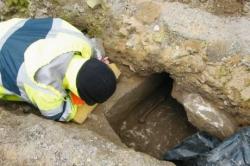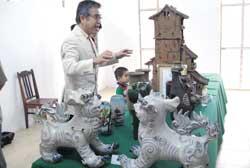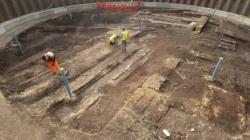INSTITUT SUPERIEUR D'ANTHROPOLOGIE
INSTITUTE OF ANTHROPOLOGY
ONLINE COURSES / COURS A DISTANCE
INSCRIPTION 2012 / Session II : Avril 2012
REGISTRATION 2012 / Term II : April 2012
FRANCE –  Neuvicq-le-Château - Un chantier d'électrification, dans la cour même du château, a mis au jour plusieurs sarcophages. Chacun est composé de cuve et couvercle. Ils contiennent des restes humains avec parfois des regroupements familiaux. Ce mercredi 21 mars, Léopold Morel, archéologue au Conseil général est venu faire un diagnostic archéologique de cette découverte. Actuellement, sans étendre les recherches une quinzaine de tombes ont été dénombrées. Elles sont intactes à seulement 50 centimètres de profondeur et à quelques mètres des fondations du château. Éloignées de l'église du village datant du XIe siècle, Léopold Morel les estime du Haut Moyen Âge (entre les VIe et le VIIIe siècles). Ces sarcophages sont taillés dans les blocs de calcaire monolithique, inexistant dans la région. Un dallage de la cour de l'ancien château féodal a aussi été découvert.
Neuvicq-le-Château - Un chantier d'électrification, dans la cour même du château, a mis au jour plusieurs sarcophages. Chacun est composé de cuve et couvercle. Ils contiennent des restes humains avec parfois des regroupements familiaux. Ce mercredi 21 mars, Léopold Morel, archéologue au Conseil général est venu faire un diagnostic archéologique de cette découverte. Actuellement, sans étendre les recherches une quinzaine de tombes ont été dénombrées. Elles sont intactes à seulement 50 centimètres de profondeur et à quelques mètres des fondations du château. Éloignées de l'église du village datant du XIe siècle, Léopold Morel les estime du Haut Moyen Âge (entre les VIe et le VIIIe siècles). Ces sarcophages sont taillés dans les blocs de calcaire monolithique, inexistant dans la région. Un dallage de la cour de l'ancien château féodal a aussi été découvert.
http://www.sudouest.fr/2012/03/23/une-necropole-merovingienne-666636-1473.php
VIET NAM –  Kim Lan - A museum of ancient pottery has been built in Ha Noi's Gia Lam District as a result of co-operation between villagers and archaeologists. The Community Archaeology Museum in Kim Lan Village, which was inaugurated on Tuesday, is the first example in the country of "community archaeology", in which local people play the main role in collecting items and building dossiers. Perhaps the first indication that ancient artefacts existed in the area occurred decades ago when Nguyen Viet Hong, 77, first began picking up broken pieces of ceramics on the sandy banks of the Hong (Red) River. Over the years, he built up a collection of pottery dating back a thousand years. Other villagers also joined in the work and they, too, found many ancient pieces. They wrote a letter reporting the situation to researchers at the Viet Nam Institute of Archaeology and the National History Museum. The researchers, including archaeologist Nishimura Masanari from Japan, came to Kim Lan Village in 2000 and were astonished when they found artefacts that dated from as far back as the 7th century. Masanari and the Vietnamese researchers joined Kim Lan villagers to collect more items and to collate and build dossiers for them. A joint project of community archaeology was launched. The Japanese archaeologist then went back to his country and raised funds for the Kim Lan Museum.
Kim Lan - A museum of ancient pottery has been built in Ha Noi's Gia Lam District as a result of co-operation between villagers and archaeologists. The Community Archaeology Museum in Kim Lan Village, which was inaugurated on Tuesday, is the first example in the country of "community archaeology", in which local people play the main role in collecting items and building dossiers. Perhaps the first indication that ancient artefacts existed in the area occurred decades ago when Nguyen Viet Hong, 77, first began picking up broken pieces of ceramics on the sandy banks of the Hong (Red) River. Over the years, he built up a collection of pottery dating back a thousand years. Other villagers also joined in the work and they, too, found many ancient pieces. They wrote a letter reporting the situation to researchers at the Viet Nam Institute of Archaeology and the National History Museum. The researchers, including archaeologist Nishimura Masanari from Japan, came to Kim Lan Village in 2000 and were astonished when they found artefacts that dated from as far back as the 7th century. Masanari and the Vietnamese researchers joined Kim Lan villagers to collect more items and to collate and build dossiers for them. A joint project of community archaeology was launched. The Japanese archaeologist then went back to his country and raised funds for the Kim Lan Museum.
http://vietnamnews.vnagency.com.vn/Life-Style/222529/ha-noi-village-opens-archaeological-museum.html
USA –  St.Augustine - The bare bones of a replica 16th-century boat are a promise of things to come at the Fountain of Youth Archaeological Park. “We’re recreating the history of St. Augustine one board at a time,” said John Stavely. The 37-foot boat being recreated was a landing craft from the Spanish ships that once anchored offshore from the park, thought to be where Menendez and his party landed in 1565. The boat is known as a chalupa (no relation to the Taco Bell product) and was a 10-oared watercraft that brought in soldiers, settlers and goods from the ships. If things go as planned, the chalupa will be the start of a boat building operation that will feature replica 16th-century Spanish vessels and canoes used by the Timucuan Indians, plus support companion maritime events. A 16th century boat building yard is under construction.
St.Augustine - The bare bones of a replica 16th-century boat are a promise of things to come at the Fountain of Youth Archaeological Park. “We’re recreating the history of St. Augustine one board at a time,” said John Stavely. The 37-foot boat being recreated was a landing craft from the Spanish ships that once anchored offshore from the park, thought to be where Menendez and his party landed in 1565. The boat is known as a chalupa (no relation to the Taco Bell product) and was a 10-oared watercraft that brought in soldiers, settlers and goods from the ships. If things go as planned, the chalupa will be the start of a boat building operation that will feature replica 16th-century Spanish vessels and canoes used by the Timucuan Indians, plus support companion maritime events. A 16th century boat building yard is under construction.
http://staugustine.com/news/local-news/2012-03-22/keel-set-chalupa-replica#.T2ylkTEaMyo
CHINE –  Zhoukoudian - In the 1930s archaeologists working at the site of Zhoukoudian near Beijing recovered an incredible trove of partial skulls and other bones representing some 40 individuals that would eventually be assigned to the early human species Homo erectus. The bones, which recent estimates put at around 770,000 years old, constitute the largest collection of H. erectusfossils ever found. They were China’s paleoanthropological pride and joy. And then they vanished. According to historical accounts, in 1941 the most important fossils in the collection were packed in large wooden footlockers or crates to be turned over to the U.S. military for transport to the American Museum of Natural History in New York for safekeeping during World War II. But the fossils never made it to the U.S. Today, all scientists have are copies of the bones. The disappearance of the originals stands as one of the biggest mysteries in paleoanthropology. Researchers have found a new lead, however. In a paper published today in the South African Journal of Science, Lee Berger of the University of the Witwatersrand in Johannesburg and Wu Liu and Xiujie Wu of the Institute for Vertebrate Paleontology and Paleoanthropology in Beijing detail their investigation into a recent report concerning the location of the missing bones. Former U.S. Marine Richard M. Bowen, now in his 80s, claimed that in 1947, when he was stationed at Camp Holcomb in the port city of Qinhaungdao during China’s Nationalist-Communist Civil War, he came across a box full of bones while digging foxholes one night. Spooked, he reburied the box. Soon thereafter his company evacuated Qinhaungdao. Because the most credible accounts of what happened to the fossils have them reaching Camp Holcomb, the researchers thought Bowen’s report worthy of further investigation. Perhaps the officer in charge of the fossils in 1941, seeing that the fossils were not going to make it on board the ship amid the wartime chaos, had chosen to bury them for later retrieval—only to never make it back. Working with information from Bowen and a local expert on the harbor, the team formulated three best guesses as to the location of the stone barracks where Bowen said he dug up the box of bones. All three sit within an area of about 200 meters by 200 meters.
Zhoukoudian - In the 1930s archaeologists working at the site of Zhoukoudian near Beijing recovered an incredible trove of partial skulls and other bones representing some 40 individuals that would eventually be assigned to the early human species Homo erectus. The bones, which recent estimates put at around 770,000 years old, constitute the largest collection of H. erectusfossils ever found. They were China’s paleoanthropological pride and joy. And then they vanished. According to historical accounts, in 1941 the most important fossils in the collection were packed in large wooden footlockers or crates to be turned over to the U.S. military for transport to the American Museum of Natural History in New York for safekeeping during World War II. But the fossils never made it to the U.S. Today, all scientists have are copies of the bones. The disappearance of the originals stands as one of the biggest mysteries in paleoanthropology. Researchers have found a new lead, however. In a paper published today in the South African Journal of Science, Lee Berger of the University of the Witwatersrand in Johannesburg and Wu Liu and Xiujie Wu of the Institute for Vertebrate Paleontology and Paleoanthropology in Beijing detail their investigation into a recent report concerning the location of the missing bones. Former U.S. Marine Richard M. Bowen, now in his 80s, claimed that in 1947, when he was stationed at Camp Holcomb in the port city of Qinhaungdao during China’s Nationalist-Communist Civil War, he came across a box full of bones while digging foxholes one night. Spooked, he reburied the box. Soon thereafter his company evacuated Qinhaungdao. Because the most credible accounts of what happened to the fossils have them reaching Camp Holcomb, the researchers thought Bowen’s report worthy of further investigation. Perhaps the officer in charge of the fossils in 1941, seeing that the fossils were not going to make it on board the ship amid the wartime chaos, had chosen to bury them for later retrieval—only to never make it back. Working with information from Bowen and a local expert on the harbor, the team formulated three best guesses as to the location of the stone barracks where Bowen said he dug up the box of bones. All three sit within an area of about 200 meters by 200 meters.
http://blogs.scientificamerican.com/observations/2012/03/22/report-from-former-u-s-marine-hints-at-whereabouts-of-long-lost-peking-man-fossils/
ROYAUME UNI - Caerau Hill - Geophysical surveys of an unexplored Iron Age hill fort in Cardiff could reveal the remains of a 2,000-year-old settlement, experts have predicted. Dr Oliver Davis, a specialist in Iron Age archaeology at Cardiff University and joint coordinator of the project, said Caerau could have been the base of “power and political control” in the area during the Iron Age. He said: “It’s one of the largest and certainly one of the most heavily-fortified or defended [sites] in southeast Wales. “It’s clearly a very important location in the Iron Age, possibly a centre of power and political control in the area.” Dr Davis added: “It is a big, big settlement, potentially with high-status people living here. Some people think tribal chiefs would have lived in the hill forts.” Local historian Sue Brooke described the project as “absolutely amazing” and said the findings of this week’s survey could “peel away the layers” at the site and uncover Iron Age fortifications. “There could be things like roundhouses up there and enclosures in which they would have kept animals as animals were an integral part of life there,”
http://www.walesonline.co.uk/news/wales-news/2012/03/23/could-time-team-visit-iron-age-ely-hill-fort-91466-30604432/
ROYAUME UNI –  Limmo Peninsula - Archaeologists working at an east London Crossrail site have uncovered remains of the historic Ironworks and Shipbuilding Company. Work is under way at Limmo Peninsula, by Canning Town, to record the remains of the shipyard, which shut in 1912. The firm employed thousands of people to build ships for navies worldwide. Crossrail said details of the shipyard were documented before digging began so it had incorporated the excavation work into its construction programme. It said tunnelling in the area where the shipyard is being excavated would begin later this year. The shipyard played a significant part in Britain's industrial history until its closure in 1912. It was the first in the world to produce iron ships - some of the most famous warships in the world were built and launched from Limmo Peninsula. The HMS Warrior, the world's first all-iron warship was completed at the site in October 1861 and was the largest, fastest, most heavily-armed and most heavily-armoured warship in the world. The company also set up a football club for their employees using the emblem of crossed hammers, which is now West Ham United. Jay Carver, Crossrail's principal archaeologist, said: "The excavations so far have uncovered evidence for the site railway, forges and a furnace and machine bases with bolts that would have secured the heavy ironworks plant to the floor.
Limmo Peninsula - Archaeologists working at an east London Crossrail site have uncovered remains of the historic Ironworks and Shipbuilding Company. Work is under way at Limmo Peninsula, by Canning Town, to record the remains of the shipyard, which shut in 1912. The firm employed thousands of people to build ships for navies worldwide. Crossrail said details of the shipyard were documented before digging began so it had incorporated the excavation work into its construction programme. It said tunnelling in the area where the shipyard is being excavated would begin later this year. The shipyard played a significant part in Britain's industrial history until its closure in 1912. It was the first in the world to produce iron ships - some of the most famous warships in the world were built and launched from Limmo Peninsula. The HMS Warrior, the world's first all-iron warship was completed at the site in October 1861 and was the largest, fastest, most heavily-armed and most heavily-armoured warship in the world. The company also set up a football club for their employees using the emblem of crossed hammers, which is now West Ham United. Jay Carver, Crossrail's principal archaeologist, said: "The excavations so far have uncovered evidence for the site railway, forges and a furnace and machine bases with bolts that would have secured the heavy ironworks plant to the floor.
http://www.bbc.co.uk/news/uk-england-london-17488425